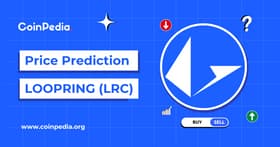The Loopring platform is built around the open protocol, which aims to make the building of decentralized exchanges more efficient and facilitate easy exchange of assets among platforms.
LRC, the ERC-20 token running on Ethereum, is the main token on the platform.
Check the current Loopring price, market cap, circulating supply, trading volume, historical statistics, etc., along with in-depth information on several of the biggest and fastest-growing cryptocurrencies on CoinStats, one of the best crypto platforms around.
CoinStats is a cryptocurrency research and portfolio tracker app that provides investment advice and valuable information on cryptocurrencies, including their real-time prices, to help investors make better decisions.
Read on to learn everything you need to know about the Loopring platform and the LRC token.
What Is Loopring
Loopring (LRC) is an Ethereum Layer-2 scaling protocol that lets users create decentralized exchanges which rival centralized exchanges in terms of performance. Loopring provides low-fee, high-speed decentralized finance (DeFi) services and allows users to sidestep the high costs and slow speeds associated with Ethereum's decentralized network. It can handle up to 1,000 times more trades per second than Ethereum, with each one costing a mere fraction of a cent.
Leveraging zero-knowledge proofs (zkRollup), Loopring claims it allows for high-performance trading (high throughput, low settlement cost) without sacrificing Ethereum-level security guarantees. Users always maintain 100% control of their assets throughout the trade lifecycle.
In 2017, Loopring hosted its own token sale, launching the LRC token, which is used to pay off on-network fees. The token raised $ 45 million from 12,000 investors.
In 2018, Loopring released Update 2.0, during which the cryptocurrency exchange process was optimized, and transaction costs were reduced. At the same time, sharing the transaction costs between participants was made possible.
Since 2019, the project has been working on the DEX exchange and the Ethereum scaling problem, which became highly relevant at the end of 2020.
In September 2020, Looping became the first decentralized exchange to integrate Band Protocol’s cross-chain oracles.
Between May and July 2020, more than a million transactions were carried out on the Loopring Exchange, allowing the project to gain thousands of new followers.
Existing centralized exchanges carry risks, including the possibility of an intermediary, regulatory intervention and fund blocking. Loopring, however, removes these barriers by providing a comfortable environment for P2P exchange within a decentralized system.
Another distinctive feature of Loopring is providing a tool for conducting token sales. In the past few years, the number of blockchain startups has increased significantly; however, almost half of them are real scammers that undermine investor confidence in such projects. Loopring has already optimized the token sale system based on smart contracts. This concept is beneficial both for projects wishing to attract seed capital and for investors who receive some kind of protection from fraud.
Loopring's zkRollup construction is designed to enable its exchanges to offer faster settlements for their customers. Rather than dealing directly with Ethereum, zkRollups allow Loopring's decentralized exchanges to perform other tasks without requiring a connection to the Ethereum blockchain. This feature enables Loopring exchanges to quickly and securely submit their transactions to the Ethereum network.
Loopring Founders
Daniel Wang is the founder and CEO of Loopring Foundation, a non-profit organization that manages the development of the Loopring protocol. He has a bachelor's degree in computer science from a Chinese University and a master's degree from Arizona State University.
Before Loopring, Wang worked at various companies such as Boston Scientific, Google, and JD.com. He has a deep understanding of both engineering and technology. Wang is the co-founder of several companies, such as Yunrang (Beijing), Information Technology Ltd., and Coinport Technology Ltd.
The Loopring team includes Chinese-born developers who have worked for major global companies. The CMO of the project, Jay Zhou, worked at PayPal and Ernst & Young. Johnston Chen, the project's chief operating officer, served as the chief information officer at 3NOD.
How Does LRC Work
Loopring’s core value proposition is its commitment to the continuous improvement of cryptography. Its core team is currently working on developing new features that will make the Ethereum blockchain more secure.
Loopring (LRC) achieves better performance than traditional decentralized exchanges by creating transactions that are executed off-chain to avoid Ethereum’s network congestion. This is done using a Layer-2 scaling solution called zkRollups, which allows a computer to claim data ownership without actually sharing it. The "zk" in zkRollup stands for "zero-knowledge" and refers to the type of proof Loopring must provide to verify that the off-chain transactions are accurate. zkRollups bundle multiple transactions into a single transaction, allowing fast and cheap trade execution outside the Ethereum blockchain. These transactions are then located on the blockchain, where zero-knowledge proofs are used to verify that off-chain transactions are correct.
Loopring is blockchain agnostic, meaning that any platform that uses smart contracts (e.g., NEO, Ethereum, Qtum) can integrate with Loopring.
LRC is the Ethereum-based cryptocurrency token of Loopring. All LRC holders can stake LRC to earn part of the protocol fees paid by all exchanges built on top of Loopring. 70% of the protocol fees are rewarded to stakers, 20% -to fund the Loopring DAO, and the remaining 10% will be burned.
In addition to the tokens sold at the ICO, the market was replenished with LRC received by miners for confirming the Proof of Work consensus during operations within the Loopring network. The project uses the LRC Burn Rate mechanism to burn tokens, thereby increasing the value of tokens on the market. The token is used to pay off the commission for Loopring transactions.
Where Can You Buy LRC
You can buy LRC on some of the major exchanges:





